

Jon Clements, Author (unless otherwise noted) and Editor
Current degree day accumulations
Massachusetts Agricultural Calendar 2016 Photo Contest
| UMass Cold Spring Orchard, Belchertown, MA |
16-May |
| Base 43 (SkyBit) | 499 |
| Base 50 (NEWA) | 177 |
Current bud stages. May 17, 2016, UMass Cold Spring Orchard, Belchertown, MA
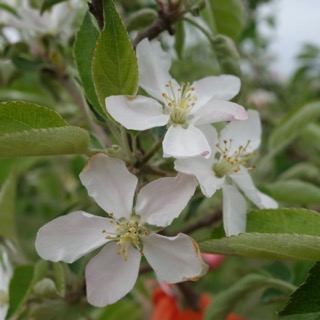 |
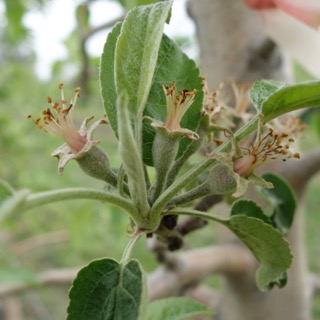 |
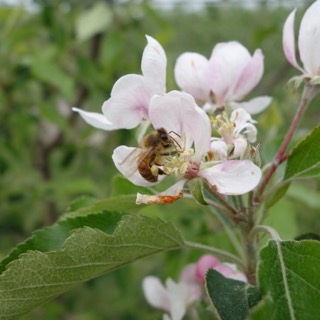 |
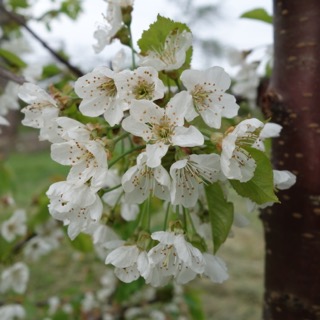 |
Honeycrisp apple bloom to late bloom |
McIntosh apple petal fall |
Gala apple bloom to petal fall |
Regina sweet cherry late bloom |
| Coming events | Degree days (Base 43 BE) |
| European red mite egg hatch complete | 368-470 |
| Lesser appleworm 1st adult catch | 271-565 |
| Lesser appleworm 1st flight peak | 354-772 |
| Lesser peachtree borer 1st adult catch | 480-676 |
| Oriental fruit moth 1st flight peak | 331-537 |
| Plum curculio oviposition scars present | 485-589 |
| Spotted tentiform leafminer mines present | 367-641 |
| White apple leafhopper leafminer mines present | 302-560 |
| McIntosh petal fall | 448-524 |
*adapted from Scaffolds Fruit Journal
Key insect life cycle and management dates (and some disease and horticuluture stuff)
Note: for 2016, we have five Massachusetts orchard locations subscribed to AR: Belchertown, Easthampton, Deerfield, Groton, Phillipston, and Sutton. The website for looking at AgRadar for these locations is: http://extension.umaine.edu/ipm/ag-radar-apple-sites/. What follows is for the Belchertown location.
Estimated apple Scab Ascopsore Maturity, 16-May -- 84%
Lesser Appleworm LAW -- 1st LAW flight begins around: May 13, Friday. Peak trap catch: May 23.
Oriental Fruit Moth OFM -- 1st generation OFM flight starts: April 23, Saturday. 1st generation 55% egg hatch and first treatment date, if needed: May 30, Monday.
Plum Curculio (PC) -- Increased risk of PC damage as McIntosh and similar varieties increase fruit size: May 22, Sunday. Earliest safe date for last PC insecticide spray: June 1, Wednesday.
San Jose Scale (SJS) -- First adult SJS caught on trap: May 20, Friday. 1st generation SJS crawlers appear: June 19, Sunday.
Spotted Tentiform Leafminer STLM -- 1st STLM flight, peak trap catch: May 8, Sunday. 1st generation sapfeeding mines start showing: May 21, Saturday. Optimum sample date is around Sunday, May 22, when a larger portion of mines are visible.
White Apple Leafhopper (WAL) -- 1st generation WAL found on apple foliage: May 13, Friday.
McIntosh Bud Stages -- Full Bloom: Tuesday, May 10; 95% Petal Fall: Monday, May 16; 100% Petal Fall: Wednesday, May 18 (yeah!)
NEW: Apple Bud Freeze Mortality Estimates -- Date: Wednesday, April 6, Estimated Potential Bud Freeze, 43%; Date: Tuesday, April 5, Estimated Potential Bud Freeze, 38%; Potential Cumulative Crop Recuction, 64%.
17-May, 2016 (Tuesday) UMass Fruit Twilight Meeting at Park Hill Orchard, 82 Park Hill Rd., Easthampton, MA. 5:30 PM. 1 pesticide credit will be offered. Light dinner/refreshments will be served. $20 meeting fee. Contact: Jon Clements, 413-478-7219. Pre-registration is not necessary.
18-May, 2016 (Wednesday) UMass Fruit Twilight Meeting at Sholan Farms, 1125 Pleasant St., Leominster, MA. 5:30 PM. 1 pesticide credit will be offered. Light dinner/refreshments will be served. $20 meeting fee. Contact: Jon Clements, 413-478-7219. Pre-registration is not necessary.
19-May, 2016 (Thursday) RIFGA Twilight Meeting, Phantom Farms, 2920 Diamond Hill Road, Cumberland, RI. 5:30 PM. 2 pesticide credits will be offered. Light dinner/refreshments will be served. $20 meeting fee (free for RIFGA members). Pre-registration is not necessary. Contact: Heather Faubert, 401-874-2967.
For more information and updates, see Upcoming Events
• Still kind of waiting for the opera to get going, apples are at bloom to petal fall, and not growing rapidly yet. Already some McIntosh are easy to "flick off" and are only about 3-4 mm in diameter. I am going to try to measure fruitlet growth in 2 sites over 3 varieties (McIntosh, Honeycrisp, Gala) but it's a job -- will try to keep reporting what I am finding. I saw some Gala that had been treated with Promalin last week during bloom, and I thought some of the fruitlets there looked really good, with upright, closing sepals and good green color. Should be interesting to see what happens there. Still thinking no petal fall thinner -- wait until we know what's growing for sure. I envision a pretty good thinning window coming on in a few days, if then you think you need to chemical thin. We really need some seasonal weather -- highs should be in the 70's -- to get things going. Hope to see you all at fruit twilight meetings this week,should be interesting.
• If you have not visited AgRadar yet, you should. Not only is there a lot of nuanced pest management status information (all degree-day driven models for insects, wetness included for diseases). Newly added is a kind of experimental "Bud freeze mortality estimates." See below for the Belchertown estimate. Now, I would not take this as gospel, but it is interesting -- all along I have been saying we can expect 50% damage, so not that far off here. One Massachusetts orchard estimate is 100%, we will see how that pans out. Again, I would look at this as just another piece of the puzzle, not the total solution certainly.
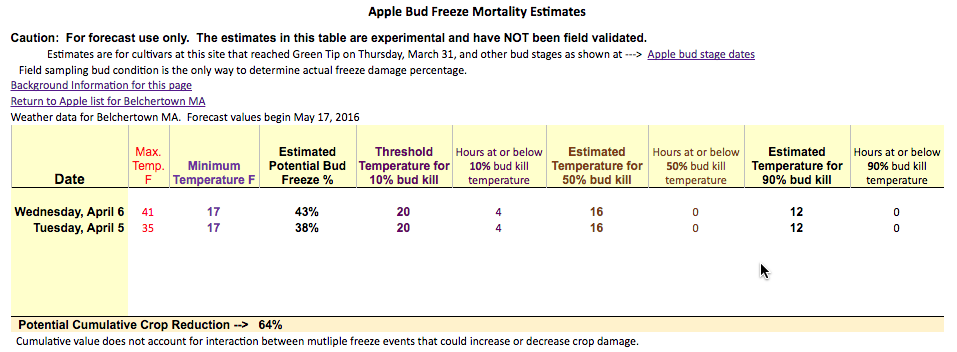
• Insects have been mostly MIA, but we caught a good flight of Oriental fruit moth last week in a pheromone trap at the UMass Orchard. That sets the biofix for the next best treatment date, which Orchard Radar says will be about May 30. Codling moth and Obliquebanded leafroller pheromone traps will be going up in the next week to 10 days.
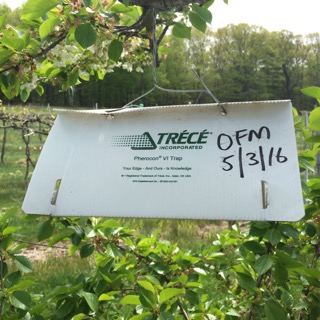 |
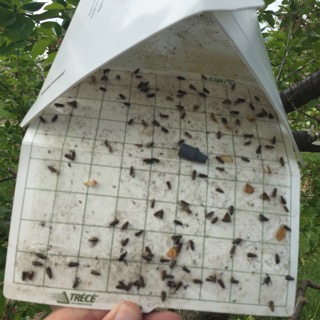 |
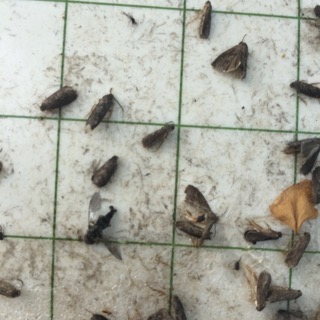 |
• Diseases are temporary past history right now, take a breath until the next rain. The fire blight risk was pretty much off the charts last Friday into Saturday, I suspect (hope?) quite a bit of streptomycin went out to those apples (and pears) still in bloom. We will see what happens now -- expect to see blossom blight symptoms from this infection event about June 2-3, and shoot blight June 13. (Again, thanks to AgRadar.) More on diseases below...
• While out scouting an orchard, we ran across this puzzling damage to several apple trees:
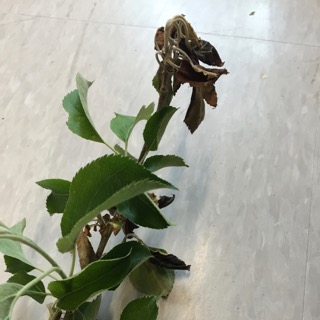 |
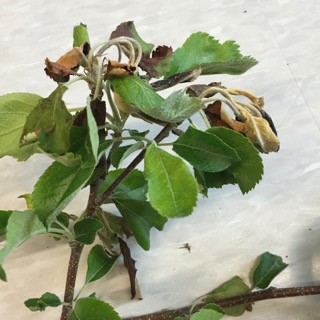 |
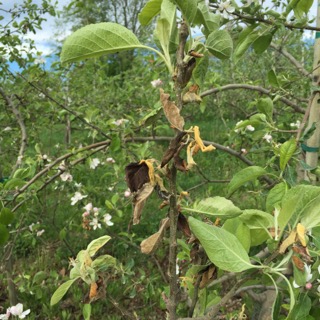 |
Fire blight? Not likely, we would not see symptoms yet from any recent infection. Apple pith moth? How did that come up? But, the damage sure fits the description. Now we just got to find one! Anyone else have an opinion? Pseudomonas syringae???
Some other observations (Liz Garofalo)
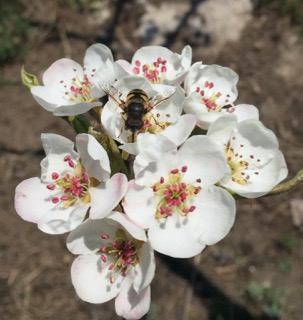 Hoverfly- thoughtful insecticide use fosters a diverse and healthy ecosystem |
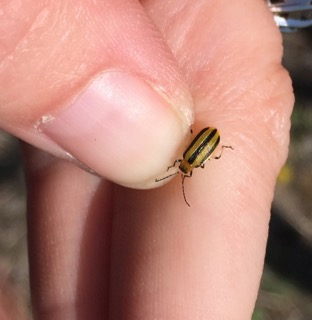 Striped cucumber beetle -- found in pear tree, what's up with that? |
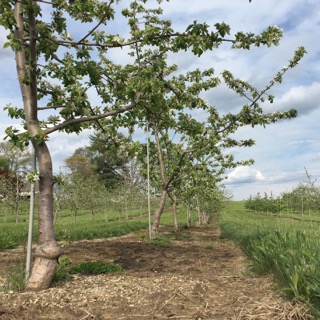 Weed free strip -- ideal weed management in the orchard looks pretty much like this, no voles, no borer hiding spots, no nutrient or water competition, no habitat for other various nasties and a good sod cover between row to prevent erosion/run off, but could be a little narrower |
• Otherwise, are you ready for the onslaught of plum curculio? According to AgRadar, at the UMass Orchard in Belchertown, plum curculio activity will increase next week, app. May 23-24. Remember, curculio typically don't bother the fruit until they become 6-7 mm in size. Be ready to apply an insecticide, Imidan still being the gold standard, this weekend or next week.
Liz Garofalo, Paul O’Connor and Dan Cooley
The fire blight watch. Last weekend, the fire blight models all skyrocketed, indicating high to extreme risk of blossom infection with wetting on Friday and Saturday. With cooler weather, the risk has essentially disappeared. Some models indicate risk goes back up this coming weekend, May 21-22, where there are still flowers in areas with some history of fire blight in previous years.
An application of streptomycin made Friday or Saturday should have been adequate to prevent any infections. Any infections that happened won’t show up for at least a couple of weeks, around Memorial Day weekend. It takes about 90 degree days with a 55ºF base for symptoms to develop. We have accumulated only a few DD since the weekend.
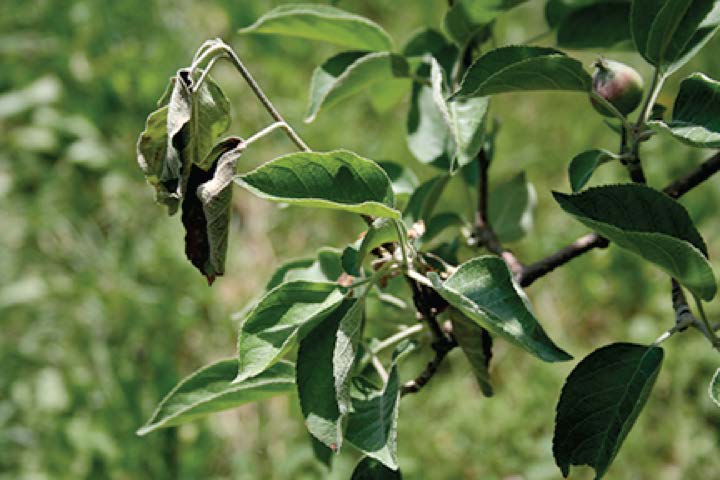
Early flagging from of a young shoot following adjacent blossom infection.
The primary season scab watch. The different models are indicating a wide range of ascospore maturity, from 75% (RIMpro) to 96% (NEWA). All but NEWA indicate at least another week before all spores will have matured. The spore observations from western MA also indicate at least 10 days before the end of primary scab season (see below).
Keep in mind that even though more than 95% of all ascospores may have matured, the last batch needs rain to release them. That rain may develop into the last infection period of primary season.
Forecasts for the next week vary. NEWA doesn’t foresee any scab infections at this point. RIMpro is predicting no infection with any rain that might come Thurs. and Fri. (May 19-20), but a major infection in a week, with rain on May 24. Ag-Radar indicates relatively minor infection events on the weekend and on May 24. Of course, as we know, forecasts change. The bottom line is that spores are available and if rain comes scab infections are possible.
Scab symptoms from any infections that might have happened during the very wet week of May 1 to 8 should begin to show up just about now. Keep an eye out.
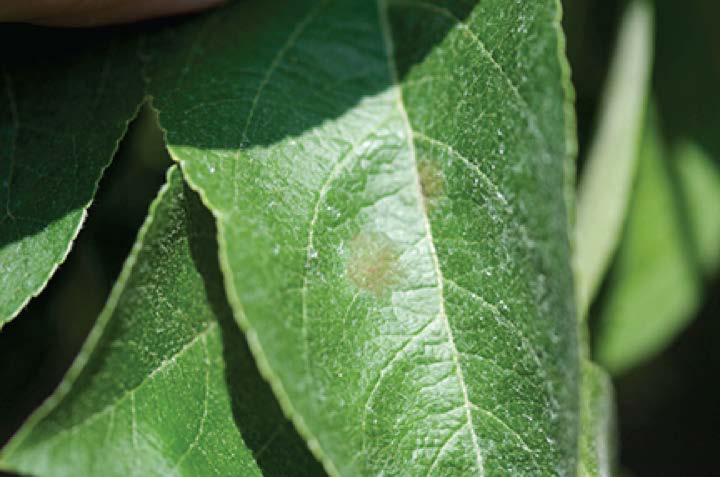
New apple scab lesions.
On to spore counts! First, a quick look into the past. On May 13, we caught 44 spores in the two-fan field trap, confirming that date as an infection event in Belchertown. The squash mounts are showing 66.9% maturity (at this point in the season, I am not putting a ton of faith in that particular number). This week in the funnel trap we counted 46 spores and 175 spores were released in the petri plate assay, which means, as I am sure you can guess, that the next time we have a daytime rain event, we are likely to see an infection event as well. So, keep an eye on that fungicide depletion and hold tight, we will be out of scab season soon!
| Ed. note: Depending on which model source you use, here are their estimates of % apple scab ascospore maturity as of 16-May (all for UMass Orchard, Belchertown, MA): SkyBit, 82%; NEWA, 96%; AgRadar 84%; RIMpro (NEWA) 75%. What do you believe? The truth is out there... |  |
Stress and canker fungi. Fungal cankers in apple trees generally show up on older trees or trees that have been stressed in one way or another. Cankers can’t be controlled using fungicide sprays, but good horticultural practices can limit their development.
Dave Rosenberger wrote an excellent review on apple canker fungi a few years ago: http://bit.ly/1TlGeeO. One of the stresses that may cause damage to trees is cold. Whether the last winter will begin to cause damage remains to be seen, as canker fungi take some time to show visible damage.
However, here’s a picture from this spring, showing heart rot in an apple this spring. You can also see that there are sunken areas on the tree bark, and flaking, loose bark, usually a sign of black rot or white rot, caused by Botryosphaeria obtuse and Botryosphaeria dothidea. Another fungus, Chondrostereum purpureum, causes a disease known as silver leaf. The fungus infects wood, often the heartwood, of a tree. Silver leaf often shows up after an extreme winter, with leaf “silvering” appearing just after petal fall.
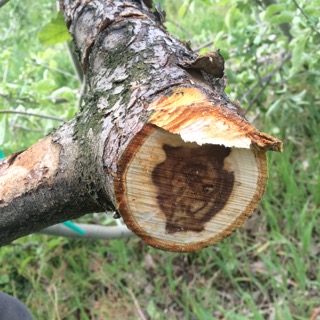
• For fruit thinning, see Duane Greene's comments below. I have just started looking at the Apple Carbohydrate Thinning Model on NEWA, and I have some reservations about it's use UNLESS you know your instruments, mostly the light sensor, are working properly. I have been told that on a cloudy day, Solar Radiation (langley's) should be about 100, while on full sunny day, it should be up around 700. Hence a range of app. 100 to 700 is in the ball park. Be sure to check yours before you put too much stock in the carbohydrate model. You can check your daily solar radiation data on NEWA here.
Thinning Decision Continue to be Difficult (Duane Greene)
The weather the past week has been unseasonably cold resulting in very slow development of fruit. I continue to be cautious when making suggestions for thinning visibly-damaged spurs. If or until fruit on spurs size to about the 6 mm range it is difficult to assess the possible damage inflicted and to estimate the initial set. If the set appears to be great enough to warrant thinning then a conservative approach seems prudent. It must be stressed that the scientific community has very little definitive information on fruit set on damaged spurs. Thinning decisions should be determined by assessing the perceived amount of damage, the extent of initial set and the predicted weather for the next several days. Weakened spurs will be more responsive to the stress imposed by weather. The carbon balance model is not a reliable guide here because it was constructed based upon the data collected from healthy spurs.
If blocks or varieties appear to show little damage and set is sufficiently great to warrant thinning you should be thinning (perhaps somewhat conservatively). The variety and the history of fruit set in a block should be factors aiding you in coming to your specific thinning decision.
What should you do? If you have some signs of damage on spurs then carbaryl is perhaps your safest (most conservative) choice. The suggestions for mild thinners start with and include carbaryl. MaxCel alone is a weak thinner. MaxCel at 32 oz/100 gal would be very mild, MaxCel at 48 Oz /100 gal would be slightly stronger and MaxCel at 64 oz/100 would be stronger but would likely to have some positive effects on final fruit size. Amid-Thin we now recommend as a bloom and petal fall spray. It is a mild thinner when used at 40 to 50 ppm (6.5 to 8 oz/100 gal.) When used at petal fall NAA can be somewhat mild. The suggested mild range for petal fall would be perhaps up to 10 ppm. The rate of NAA at the 10-12 mm stage should be reduced from this depending on the variety. I suggest that you do not combine MaxCel and carbaryl even if they are applied separately and a few days apart. This combination is one of the strongest thinning combinations you have available.
It is good to remember that we are still in the early part of the thinning season and you will have more opportunities when initial set and potential crop load is clearer. I do not say that to provide you with an opportunity to procrastinate. The best way to determine how many fruit are going to set and continue to grow and how effective previous thinners are working is to use the Fruit Growth Model and to measure fruit as outlined in the suggestions for precision thinning. Let results from measuring fruit be your guide in making later thinning decisions.
No guest article this week...
Follow me (jmcextman) on FB: https://www.facebook.com/jmcextman
UMass Fruit Advisor: http://umassfruit.com
Scaffolds Fruit Journal: http://www.nysaes.cornell.edu/ent/scafolds/
Network for Environment and Weather Applications (NEWA): http://newa.cornell.edu
Follow me on Twitter (http://twitter.com/jmcextman) and Facebook (http://www.facebook.com/jmcextman)
Massachusetts Agricultural Calendar 2016 Photo Contest (Deadline is June 1)
The next Healthy Fruit will be published on Tuesday, May 24 (or thereabouts), 2016. As always feel free to get in touch with any member of the UMass Fruit Team (http://extension.umass.edu/fruitadvisor/team-members) if you have questions or comments.